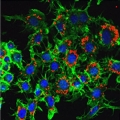Home > Press > Defying Expectation - Cellular Uptake of Nanoparticles
 |
Abstract:
Where previously materials with useful properties have seen widespread application prior to the discovery of their potentially undesirable behaviours - asbestos comes to mind - the introduction of new materials to our living and working environments is now preceded by ever more complex and rigourous testing.
Defying Expectation - Cellular Uptake of Nanoparticles
Germany | Posted on November 24th, 2011Nanomaterials in particular have become a part of the collective consciousness, and not just because of the myriad cautionary science fiction based on this size regime: Nanoparticles of all shapes and compositions are popping up with increasing regularity in research fields from electronics to medicine but, because of their often surprisingly different behaviours as compared to their bulk counterparts, it is even more important to be able to predict and control their interactions before giving them the green light.
As regards the human body's ability to deal with foreign materials, studies of the uptake and retention of nanoparticles in different organs are becoming more frequent in an effort to prove or improve the safety of these particles in environments where we are likely to come into direct contact with them.
Medicine is an obvious example, where nanoparticles have shown great promise as agents for targeted drug or gene delivery, chemotherapy, and non-invasive imaging. However, in such cases it is highly desirable to be able to engineer particles able to evade the body's clearance mechanisms, at least for long enough to deliver a drug payload to an appropriate site in the body, for example.
With that in mind, a group working in Dublin has investigated the quantitative effect of particle size on the uptake efficiency and localisation of carboxylated polystyrene nanoparticles across cell lines from different parts of the human body, representative of the main avenues of exposure to such particles, as well as the variation in uptake kinetics for the different cell types. Their confocal microscopy and flow cytometry results suggest that nanoparticle uptake defies the expected size limits for uptake processes: a result which has important implications for the future safety assessments of these nanomaterials.
####
For more information, please click here
Copyright © Wiley-VCH Materials Science Journals
If you have a comment, please Contact us.Issuers of news releases, not 7th Wave, Inc. or Nanotechnology Now, are solely responsible for the accuracy of the content.
| Related Links |
![]() Tiago dos Santos, Small, 2011 ; DOI: 10.1002/smll.201101076
Tiago dos Santos, Small, 2011 ; DOI: 10.1002/smll.201101076
| Related News Press |
News and information
![]() Simulating magnetization in a Heisenberg quantum spin chain April 5th, 2024
Simulating magnetization in a Heisenberg quantum spin chain April 5th, 2024
![]() NRL charters Navy’s quantum inertial navigation path to reduce drift April 5th, 2024
NRL charters Navy’s quantum inertial navigation path to reduce drift April 5th, 2024
![]() Discovery points path to flash-like memory for storing qubits: Rice find could hasten development of nonvolatile quantum memory April 5th, 2024
Discovery points path to flash-like memory for storing qubits: Rice find could hasten development of nonvolatile quantum memory April 5th, 2024
Discoveries
![]() Chemical reactions can scramble quantum information as well as black holes April 5th, 2024
Chemical reactions can scramble quantum information as well as black holes April 5th, 2024
![]() New micromaterial releases nanoparticles that selectively destroy cancer cells April 5th, 2024
New micromaterial releases nanoparticles that selectively destroy cancer cells April 5th, 2024
![]() Utilizing palladium for addressing contact issues of buried oxide thin film transistors April 5th, 2024
Utilizing palladium for addressing contact issues of buried oxide thin film transistors April 5th, 2024
Announcements
![]() NRL charters Navy’s quantum inertial navigation path to reduce drift April 5th, 2024
NRL charters Navy’s quantum inertial navigation path to reduce drift April 5th, 2024
![]() Discovery points path to flash-like memory for storing qubits: Rice find could hasten development of nonvolatile quantum memory April 5th, 2024
Discovery points path to flash-like memory for storing qubits: Rice find could hasten development of nonvolatile quantum memory April 5th, 2024
Environment
![]() Billions of nanoplastics released when microwaving baby food containers: Exposure to plastic particles kills up to 75% of cultured kidney cells July 21st, 2023
Billions of nanoplastics released when microwaving baby food containers: Exposure to plastic particles kills up to 75% of cultured kidney cells July 21st, 2023
Safety-Nanoparticles/Risk management
![]() Tests find no free-standing nanotubes released from tire tread wear September 8th, 2023
Tests find no free-standing nanotubes released from tire tread wear September 8th, 2023
![]() Billions of nanoplastics released when microwaving baby food containers: Exposure to plastic particles kills up to 75% of cultured kidney cells July 21st, 2023
Billions of nanoplastics released when microwaving baby food containers: Exposure to plastic particles kills up to 75% of cultured kidney cells July 21st, 2023
|
|
||
|
|
||
| The latest news from around the world, FREE | ||
|
|
||
|
|
||
| Premium Products | ||
|
|
||
|
Only the news you want to read!
Learn More |
||
|
|
||
|
Full-service, expert consulting
Learn More |
||
|
|
||








